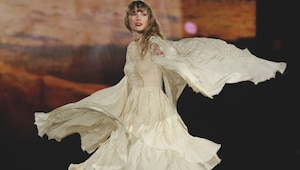Everything You Need to Know About Nose Piercings
Types of piercings, healing time, and more

Thinking about getting a nose piercing? You're in the right place. Welcome to Nose Piercing 101: Cosmopolitan's handy guide to what to expect at your trip to the jewellery counter. Maybe you're trying to choose between a septum piercing or a nostril stud; maybe you're wondering how much pain to expect, or maybe you've got questions about the healing process. Read on, because we're covering all the basics, right this way. (And if you're weighing up other body metal, check out our guides to ear piercings, helix piercings, and nipple piercings. If you're a first-timer, read up on everything you should expect with your first piercing.)
Types of nose piercings
You're probably already familiar with the nostril piercing, where people wear a small stud or a hoop ring. But there's also the septum piercing, which is done in the in the "sweet spot" of softer flesh below the cartilage separating your nostrils. Septum piercings, once considered more "punk" or fringe, have been gaining popularity over the years, thanks in part to celeb fans like Rihanna, Bella Thorne, Willow Smith, and FKA Twigs.
You might have also seen the bridge piercing, where people wear a bar through the skin at the top of the nose, between the eyes. Not for the faint of heart. Some people choose the Nassallang piercing, aka two symmetrical nostril studs worn on both sides of the nose. For more extreme looks, there's also the Austin Bar, the septril, and the rhino piercing, though these are trickier to achieve, and on the upper end of the pain and healing time scale. For any body piercing, it's important to go to a licensed and well-reviewed professional for your own safety. But if you're opting for a more unusual nose piercing, like the latter mentioned ones, you definitely want to find a highly experiences piercer who can demonstrate examples of their work showing the kind of piercing you want.
Do nose piercings hurt?
Nose piercings will likely sting a little more than when you got your first earlobe piercing at Claire's. But it shouldn't feel unbearable: many people rate nose piercings as a 3 or 4 out of 10 on a pain scale. It will probably sting or tickle sharply for a moment (it might make you sneeze), but then that pain should quickly subside, and leave a slightly bruised or warm feeling in its place. People typically report slightly more pain with septum piercings than they do with nostril piercings; and the more extreme or unusual piercings might be the most painful. It's worth noting that everyone's pain tolerance is different though, so what some people find uncomfortable, others may not mind at all.
How to care for a nose piercing
For a happy nose piercing, the secret's all in the aftercare. (Well, that, and going to a legit piercing parlour, of course.) Your piercer should provide you with full instructions on how to care, but it will likely involve spraying the area with saline solution daily to keep it clean. Whether you are meant to gently twist your jewellery, or leave it alone entirely while it heals, will be down to the type of piercing you get, and your piercer's advice. But typically, you shouldn't change or remove your jewellery for at least 6 weeks, unless you need to remove it due to infection or prolonged discomfort. If you feel the need to remove and replace the jewellery because of discomfort, it's best to go back to the piercing counter for help with this, especially if you're still in the initial healing window.
And what about your nighttime routine? Firstly, you should avoid touching the area as much as possible, but if you must, always do it with clean hands. Simple, fragrance-free skincare that skips the immediate area around your piercing is ideal. But if you're committed to your 12-step skincare routine, try not to bathe your new nose ring in a million different serums and potions - that's a recipe for major irritation. Try not to sleep on it, and be extra-careful when taking any clothes off over your head so it doesn't snag. If you're experiencing swelling, gently applying an ice compress wrapped in a clean cloth should help.
How long do nose piercings take to heal?
Everyone's body and skin are different, so healing times vary. How fast it heals can also be correlated to how well, and how gently, you are caring for it. But pierced nostrils will often heal in 2-4 months, and septum piercings might take closer to 4-6 months. For some people's it's longer.
Jewellery for nose piercings
People commonly choose hoops or studs for nostril piercings. At first many piercing parlours will advise that a stud is worn in the nostril until it heals, and after that, it can be safely swapped out for a hoop. Septum piercings are often fitted with hoops or horseshoes, but sometimes people opt for a bar.
In terms of the metals used, surgical stainless steal is an affordable and commonly used material. Titanium is too, though that will set you back more £££. Sterling silver and gold can also be used, but it's best to seek the advice of a licensed piercer who can tell you what will work for your particular piercing and skin sensitivity level. Avoid gold-plated pieces - while more affordable than solid gold, the gold plate can rub off, revealing a cheaper, more irritating metal.
Nose piercing side effects
Okay, this is the icky section - but it's stuff worth knowing. Head major irritation off at the pass by letting your piercer know if you're allergic to any metals, such as nickel, so that you can choose the safest jewellery for your bod. While the site is healing, you might notice a little crust forming at the piercing site (sorry), but this can be taken care of by regularly using saline spray.
If you're experiencing pain or swelling at the site that doesn't reduce with a cold compress, it's best to seek medical attention to combat any potential infections. You may notice a small "piercing bump" at the site, which is normal due to inflammation. But if the bump grows bigger, or starts to extend beyond the piercing site, this could be a sign of keloid scarring, and it's best to seek professional advice. Basically, if you're experiencing major discomfort, or something doesn't look or feel right, it's always best to show a doctor. If you can't get to the doctor straight away, your piercing professional should be able to help you with some advice in the meantime.
more from Beauty

Exactly why your skin looks dull and breaks out before your period, according to dermatologists

Great “text chemistry” is the new love language of Gen Z dating—but almost no one’s fluent in it

Mandira Bedi: “Young women can now play cricket without apology or hesitation”

How Zohran Mamdani won the NYC mayoral election by keeping it real

Are couples who meet offline happier than those who match on the apps?

Shafali Verma: “Everything starts with believing in yourself”

"Going phone-free for a week was harder than going sober for a year: 3 lessons I learnt the hard way"

A pocketful of love: Perhaps putting hands in each other’s back pockets is GenZ's way of returning to old-school love

Is 'bhajan clubbing' the coolest new way to party in India?

Ranking every Taylor Swift album, from debut to ‘The Tortured Poets Department’
